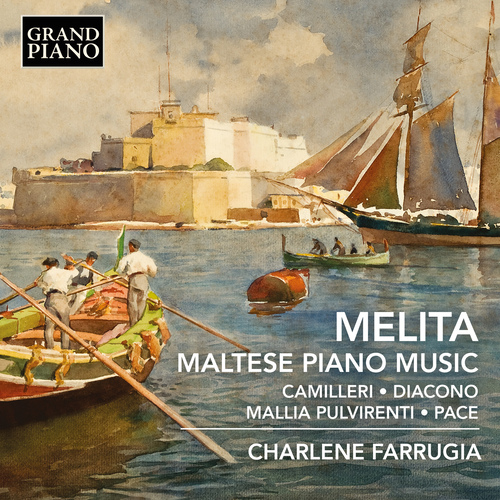
About this Release
Catalogue No.: GP949
Release Date: April 2025
Barcode: 747313994915
Artist(s): Charlene Farrugia
Link(s):
MELITA
Camilleri • Diacono • Mallia Pulvirenti • Pace
- Charlene Farrugia, piano
Positioned between Southern Europe and North Africa, Malta has long been an artistic crucible that forms one of the Mediterranean’s most significant cultural crossroads. With its intense pianistic colours, Charles Camilleri’s African Dreams explores that continent’s native rhythms and melodic lines, while Carmelo Pace and Carlo Diacono look towards the worlds of Liszt and Chopin. Josie Mallia Pulvirenti’s rarely heard Impressione Sinfonica is a concert masterpiece of virtuosic majesty, steeped in the piano’s Golden Age. Award-winning Maltese pianist, Charlene Farrugia, has done extensive research into the life and work of composers from her homeland.
Tracklist
|
Camilleri, Charles
|
|
African Dreams (1965) (00:22:00 )
|
|
1
I. Hymn to Morning (00:03:15)
|
|
2
II. Rain Forest Fantasy (00:03:37)
|
|
3
III. Experience of Conflict (00:04:35)
|
|
4
IV. Festival Drumming (00:02:37)
|
|
5
V. Children's Lagoon (00:04:20)
|
|
6
VI. A Dance: Ritual Celebration (00:03:10)
|
|
Pace, Carmelo
|
|
Piano Sonata No. 2 (1973) (00:17:30 )
|
|
7
Andante - Allegro - (00:06:52)
|
|
8
Lentamente - (00:05:44)
|
|
9
Allegretto scherzoso - Largo - Allegretto (00:04:57)
|
|
Diacono, Carlo
|
|
10
Fantasie-Impromptu (1928) (00:06:02)
|
|
Pace, Carmelo
|
|
4 Bagatelles (1979) (00:10:00 )
|
|
11
No. 1. Andantino - (00:01:50)
|
|
12
No. 2. Lento - (00:03:10)
|
|
13
No. 3. Allegretto scherzoso - (00:01:46)
|
|
14
No. 4. Vivo - Largo - Vivo (00:03:16)
|
|
Mallia Pulvirenti, Josie
|
|
15
Impressione Sinfonica (version for piano) (1922) (00:17:25)
|
Total Time: 01:12:36
The Artist(s)
 Maltese pianist Charlene Farrugia studied with Dolores Amodio and Diana Ketler at the Royal Academy of Music in London. She was subsequently mentored by Boris Petrushansky for several years. Farrugia gained her doctorate in performance under Kenneth Hamilton with a thesis on piano repertory for the left hand. In 2018 she received Malta’s International Achievement Award, and in 2020 she was made an Associate of the Royal Academy of Music in recognition of her contribution to the music profession. An ambassador of EMMA for Peace (Euro Mediterranean Music Academy), under the auspices of UNESCO, she is currently associate professor of piano at the Academy of Music of the Juraj Dobrila University in Pula, Croatia. She has toured widely, with engagements taking her throughout Europe to North America and the Far East.
Maltese pianist Charlene Farrugia studied with Dolores Amodio and Diana Ketler at the Royal Academy of Music in London. She was subsequently mentored by Boris Petrushansky for several years. Farrugia gained her doctorate in performance under Kenneth Hamilton with a thesis on piano repertory for the left hand. In 2018 she received Malta’s International Achievement Award, and in 2020 she was made an Associate of the Royal Academy of Music in recognition of her contribution to the music profession. An ambassador of EMMA for Peace (Euro Mediterranean Music Academy), under the auspices of UNESCO, she is currently associate professor of piano at the Academy of Music of the Juraj Dobrila University in Pula, Croatia. She has toured widely, with engagements taking her throughout Europe to North America and the Far East. The Composer(s)
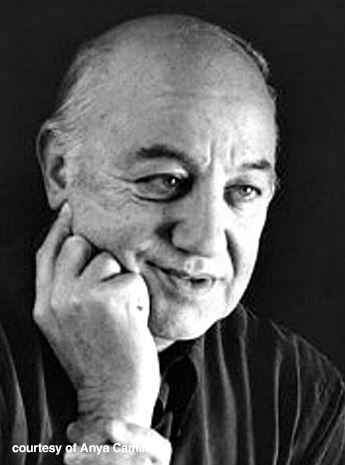 Charles Camilleri was born in Hamrun, Malta, in 1931. He showed early promise as an accordionist and pianist and started composing at the age of eleven. By the end of his teens he had written a number of compositions inspired by Maltese traditional music and, particularly, by the local style of folk singing known as għana. When Camilleri was eighteen, he emigrated to Australia and eventually moved to London where he earned his living as a successful light-music arranger, performer, composer and conductor, assisting Sir Malcolm Arnold on the Oscar-winning soundtrack of The Bridge on the River Kwai. In 1958 Camilleri left London for New York and then Canada, where he studied composition whilst working as resident conductor for the Canadian Broadcasting Corporation. He would eventually describe these “electrifying” years as amongst the most exciting of his life. They certainly gave him the confidence to dedicate himself to composition, which he did on his return to London in 1965. The following years brought him ever-increasing critical acclaim and prestigious collaborations. 1977 saw Camilleri’s appointment as Professor of Composition at the Royal Conservatory of Music, Toronto. Camilleri also gave lectures at Buffalo State University, a hotbed of musical modernism, where he met experimental composers such as Carter, Feldman and Cage. Their influence took root in a number of works of this period including the Organ Concerto (1981).
Charles Camilleri was born in Hamrun, Malta, in 1931. He showed early promise as an accordionist and pianist and started composing at the age of eleven. By the end of his teens he had written a number of compositions inspired by Maltese traditional music and, particularly, by the local style of folk singing known as għana. When Camilleri was eighteen, he emigrated to Australia and eventually moved to London where he earned his living as a successful light-music arranger, performer, composer and conductor, assisting Sir Malcolm Arnold on the Oscar-winning soundtrack of The Bridge on the River Kwai. In 1958 Camilleri left London for New York and then Canada, where he studied composition whilst working as resident conductor for the Canadian Broadcasting Corporation. He would eventually describe these “electrifying” years as amongst the most exciting of his life. They certainly gave him the confidence to dedicate himself to composition, which he did on his return to London in 1965. The following years brought him ever-increasing critical acclaim and prestigious collaborations. 1977 saw Camilleri’s appointment as Professor of Composition at the Royal Conservatory of Music, Toronto. Camilleri also gave lectures at Buffalo State University, a hotbed of musical modernism, where he met experimental composers such as Carter, Feldman and Cage. Their influence took root in a number of works of this period including the Organ Concerto (1981).  Prolific and refined, Carlo Diacono, from Żejtun, south east Malta, studied with Paolino Vassallo, a leading light in Paris during the late 1870s and 1880s. ‘Of the great Maltese composers up to his generation, [he was] the only one who did not study abroad’. Selected for highest office, he was appointed maestro di cappella at Mdina Cathedral and St John’s Co-Cathedral Valletta in 1923, succeeding Vassallo.
Prolific and refined, Carlo Diacono, from Żejtun, south east Malta, studied with Paolino Vassallo, a leading light in Paris during the late 1870s and 1880s. ‘Of the great Maltese composers up to his generation, [he was] the only one who did not study abroad’. Selected for highest office, he was appointed maestro di cappella at Mdina Cathedral and St John’s Co-Cathedral Valletta in 1923, succeeding Vassallo.  Valletta-born, Mallia Pulvirenti studied locally with Vassallo and with the composer-organist Giulio Bas in Milan, graduating from the Conservatorio in 1936. Involved in the family business, his catalogue was modest but accomplished.
Valletta-born, Mallia Pulvirenti studied locally with Vassallo and with the composer-organist Giulio Bas in Milan, graduating from the Conservatorio in 1936. Involved in the family business, his catalogue was modest but accomplished.  A reticent recluse trained locally, speculatively autistic, taking correspondence courses in composition, devoting himself to teaching, and pursuing a relentless work ethic, he rarely left the place, living in Sliema. Pioneering folklorist and għana proponent from at least the early 1930s – ‘the first composer to take an active interest in Maltese folk music’ (Joseph Vella, 1994) – his output was copious. Over 500 scores, including operas, symphonies, concertos and ten numbered string quartets. Most remain obscure and unpublished.
A reticent recluse trained locally, speculatively autistic, taking correspondence courses in composition, devoting himself to teaching, and pursuing a relentless work ethic, he rarely left the place, living in Sliema. Pioneering folklorist and għana proponent from at least the early 1930s – ‘the first composer to take an active interest in Maltese folk music’ (Joseph Vella, 1994) – his output was copious. Over 500 scores, including operas, symphonies, concertos and ten numbered string quartets. Most remain obscure and unpublished. 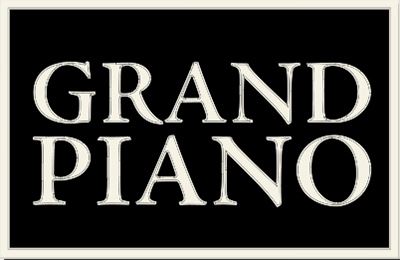
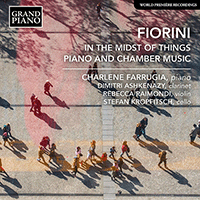
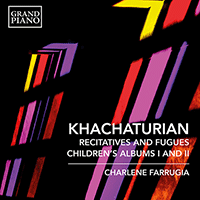
 Grand Piano has gained a reputation for producing high quality recordings of rare keyboard gems. Dedicated to the exploration of undiscovered piano repertoire, the label specialises in complete cycles of piano works by many lesser-known composers, whose output might otherwise have remained unknown and unrecorded.
Grand Piano has gained a reputation for producing high quality recordings of rare keyboard gems. Dedicated to the exploration of undiscovered piano repertoire, the label specialises in complete cycles of piano works by many lesser-known composers, whose output might otherwise have remained unknown and unrecorded.






